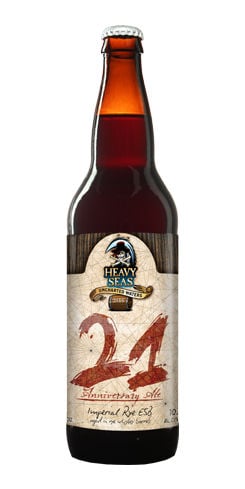This is an Imperial Rye ESB judged as English Barleywine BJCP #17D. My assistant greets me with a tall glass of copper colored beer capped with an inch of off-white dense foam, intoning “Imperial Rye ESB”. Hmmm. This presents a bit of a challenge for classification. Naturally, I look to the moniker ESB for roots – English real ale of a strong-ish sort, often deeply amber in color and rich in malt with classic English herbal, earthy, and slightly woody tones from U.K hops. What to do about Imperial? That seems fairly straightforward in the it is a very strong version therein. But how strong? Rye? That’s a bit of a curve. I have a modest group initially to consider: English Strong Ale, Old/Stock Ale, English Barleywine all seem possible, and then depending on the rye character, maybe even a special grain variant on one of those three (you never know!). I took a cautious route and decided to let the beer speak to me and then see what made sense.
As noted the beer is gorgeous: a deeply saturated copper with red tones with a light and dense foam of lingering presence, sustained with regular outgassing. The aroma is malty rich and vinous, with a caramel/candied sugar front with some dark candied-cherry fruit and a spicy-toasty back, overlain on an herbal-earthy note of sage, savory, and epazote that provides a mild counterpoint to the lingering sweet richness and alcohol evident in the nose. As the beer warms the spicy/phenolic and grainy element from the rye become a tad more pronounced. Overall the nose is massive in malt with some angular complexity and a big shot of alcohol.
The initial flavor is strong with spicy-malt and a modest bitterness, only slightly dulling the lush sweetness of the malt that manages to remain in dominance throughout the taste profile. Deeply dark candy/caramel and dried candied fruits (cherries, elderberries) and a respectable herbal note are complimented by the reemergent rye character in the mid-palate. To the end the malt remains powerful, trailing to a big and lingeringly off-dry (bordering on sweet) finish with some herbal hop and a hint of woodiness complimenting the late mouth sweetness. The taste profile is interesting in that its very malt-forward, but the strong rye character along with dry-herbal, tea-like hops do a good job of providing balance and keeping the beer from being cloying. Mouthfeel is viscous and very full; a hint of astringency is likely sourced from the rye malt, but isn’t out of place: like the spiciness in the flavor, it provides counterpoint to what might otherwise be a simply too sweet beer. Overall the beer has a nice, sweet and lush malt character, complimented by both rye and English style hops and a bit of aged woodiness. The profile would seem to fit either the Stock Ale or English Barleywine variants of the tribe, but given its expressed ethanol character, I’ll opt for calling it the latter. While the rye character is fairly obvious and deft, I’m not sure it presents enough uniqueness to call out stylistically.
No matter, this is a fine beer of big and assertive flavor and strength, with clear English pedigree. It hits all the right notes of deep, rich and fruity maltiness, some balancing herbal hop notes, and a lingering alcoholic heat, albeit a bit peculiar (or should I say peculier?) given the rye. The strength and driving rich maltiness certainly lend itself well to a mid-winter digestif enjoyed in front of the hearth. I like it; I like it, indeed.




